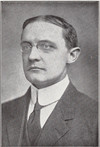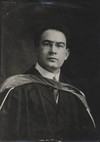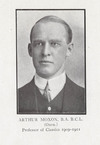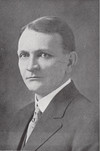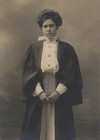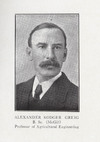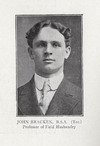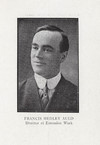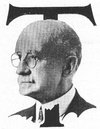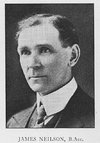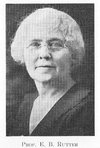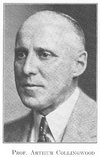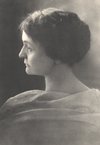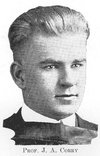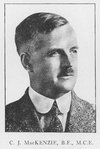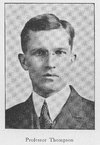“That Company of Gentlemen Adventurers”1 – The First Faculty
Murray had less than one year from the date of his appointment until the beginning of classes – and therefore a pressing concern was the hiring of capable faculty. Although he did not persuade everyone he had hoped to, on the whole Murray was able to attract people of significant ability, and apparently fearless if not actually intrigued at the prospect of helping to create a new University. Although the first – and certainly a majority – of faculty hired during Murray’s tenure were men, he hired a number of very capable women. Some, like Jean Bayer and Mabel Timlin, began their careers in secretarial positions, earned advanced degrees while on staff, and joined the ranks of faculty.
The “first five,” including Murray who taught philosophy, were:
George Herbert Ling (1874?-1942): was the first professor of mathematics at the University, and its first dean of Arts and Science, a position which he held from 1911 until his retirement in 1938. Ling was awarded an honorary degree by the University in 1939. Upon his death, the National Conference of Canadian Universities passed a resolution stating in part: “By his high and exacting standards alike in matters of the mind and of character, [Ling] let a permanent impression on the life of the University. These standards gained in strength by his own acceptance of them for the ordering of his personal conduct. … He took a decisive share in the foundation and subsequent direction of this Conference….From all who came to know his great qualities of heart and mind he received an admiring affection which leaves a profound sense of loss in his death.” As was noted in the Green and White, Ling “could call by name nearly all the thousands of students who for 27 years had been enrolled in the College of Arts and Science….No man of greater integrity ever lived.”
Edmund Henry Oliver (1881-1935): Oliver gave the University’s first lecture in 1909; set its first examination; gave the first extension lecture; and edited the first book of documents dealing with Saskatchewan history (King, The First Fifty). His work collecting historical documents of permanent value formed the genesis of both the University Library’s Special Collections department, and the Saskatchewan Archives Board. During World War I, he created the “University of Vimy Ridge.” As Moderator of the United Church, Murray wrote that Oliver “was one of the first to realize the magnitude of the losses and sufferings [created by the Depression]…and to awaken the Church and Governments to the seriousness of the situation. There is little doubt that his great exertions on behalf of the suffers shortened his life.”
Arthur Moxon (1881-1963): Moxon was professor of Classics and Law, later becoming Dean of the College of Law; and served on the University Senate; on the Board of Governors, including a term as chair; and in 1953 received an honorary degree from the University. The College of Law Alumni Association established a scholarship for post-graduate study in his honour. Described during the University’s golden jubilee in 1959 as “one of the architects of Saskatchewan’s future,” Moxon “served the University almost continuously and very effectively as professor, dean, senator, chairman of the Board, and adviser and helper to everyone on matters both academic and personal. …He instilled in his students a pride in their profession, and a sense of integrity. He was a firm believer in the efficacy and morality of government under the rule of law, and a staunch believer in democracy.” At the time of his death, Moxon was the University’s solicitor. He was the last surviving of the original five faculty members.
Reginald John Godfrey Bateman (1883-1918), first professor of English. Bateman had enlisted as a private in the 28th Battalion CEF in September 1914 and served in France. Recalled in 1916 to take command of the Saskatchewan Company of the Western Universities Battalion and promoted to the rank of major, Bateman voluntarily reverted to the rank of lieutenant to return to France in 1917, where he was wounded. He returned to France once more, as Captain of the 46th Battalion CEF, where he was killed in action on 3 September 1918. “A war like the present,” he wrote, “gives a man a chance to cancel at one stroke all the pettiness of his life.” As a tribute to a man universally admired, his grief-stricken colleagues published a book of his lectures and writings.
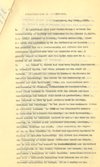 Recommendation for appointment, including Oliver, Ling, Greig
Recommendation for appointment, including Oliver, Ling, Greig
Also appointed in 1909, but not immediately teaching faculty, were:
William John Rutherford:“The University of Saskatchewan...suffered a national loss” with the unexpected death of the Dean of Agriculture, William Rutherford, on 1 June 1930. Rutherford had been Deputy Minister of Agriculture and had endorsed the idea that a College of Agriculture should become an integral part of the University. In 1909 Rutherford left the civil service to become a member of faculty at the newly established University. Rutherford unquestionably created a College of Agriculture that served well the people of the province, and “had more to do with the shaping of agricultural policies than any other man in Saskatchewan.” He served on numerous Royal Commissions: on conservation, on technical and industrial education, on lands for soldier settlement, on drought areas, on wheat marketing. Murray wrote that Rutherford had “a rare gift for friendship.” “Above all,” Murray wrote, Rutherford’s “deep interest in everything pertaining to the well-being of his fellow citizens enabled him to render a service, not only to Agriculture and to Education, but to national affairs that has rarely been surpassed in this Province.”
Jean Gordon Bayer (1884-1945) began her career with the University as Walter Murray’s secretary, also serving as librarian from 1909-1912. Although always qualified to do so, with both a BA (1908) and MA (1909) from Dalhousie, staffing shortages during World War I were the impetus which enabled Bayer to begin teaching English classes. She proved so effective she was encouraged to continue, and took a year of study at Bedford College, London, prior to being formally appointed to the faculty. Like Murray, “she possessed a wide vision of the function of a university and, like him, she…dedicated herself to Saskatchewan.” “A most kindly guide” to her students, “many caught their first glimpse of what a literary ‘salon’ of the great days might have been in the genial atmosphere of tea and literature in her book-lined suite. She was a most loyal and cooperative colleague….She made it seem an easy thing to be happy and brave.”
Alexander Roger Greig (1872-1947). Greig accepted concurrent appointments at the University as professor of mechanical engineering (1909-1937) and superintendent of buildings (1909-1939). In 1939 he accepted an appointment as acting professor of mechanical engineering at the University of Alberta, where he remained until 1943.
John Bracken (1883-1969), professor of Field Husbandry from 1909-1920. He later served as premier of Manitoba from 1922 to 1943. In 1942 he was asked to lead the federal Conservative Party, which he agreed to do with the stipulation that “progressive” be added to the party name. He remained leader until 1948.
Among the other notable faculty hired during Murray’s tenure, were:
Thomas Nathaniel Willing (1858-1920) came west as a surveyor and fought at the battle of Frenchman’s Butte during the 1885 Resistance. He was appointed chief weed inspector and chief game guardian for what is now Saskatchewan prior to his appointment with the University of Saskatchewan in 1910, as professor of natural history.
Francis Hedley Auld (1881-1967). Auld left the provincial department of Agriculture to become the University’s Director of Extension Work, from 1910-1912. Two years following his return to government work, Auld became deputy minister of agriculture – a position he held for the next 30 years, under 10 different ministers. The University awarded him an honorary degree in 1938. He retired in 1947. From 1947 to 1963 he served on the University Senate; was university chancellor from 1948 to 1965; and until 1966, was a member of the Board of Governors of St. Andrew’s College.
Alexander Campbell (1852-1943) had a remarkable life and career. Called into active service in 1885 as a member of the 7th Fusiliers from London, Ontario, by the time Campbell’s unit arrived the Northwest Resistance was over. Campbell joined the University in 1914 and retired in 1927 as Dean of Pharmacy.
James A. Neilson (1871?-1949). City auditor from 1911 to 1914, Neilson was appointed bursar for the University in 1914 and professor of accounting the following year. Accounting was then a school within Arts and Science; in 1936, it was given college status and Neilson was named Dean, a position he held until his retirement in 1941. By special by-law, Neilson was made a life member of the Institute of Chartered Accountants in recognition of his service to the profession.
Walker Stewart Lindsay (d. 1979) joined the University in 1919 as professor of pathology and bacteriology and in 1926 became dean of the newly formed School of Medical Sciences. He retired from the University in 1952 but continued to serve the developing University Hospital, where from 1956-1960 he was assistant medical director. The University awarded Lindsay an honorary degree in 1955 and in 1971, established a named chair in the College of Medicine in his honour.
Francis Melville Quance (1883-1968), first Dean of Education, was nationally known for the “Quance Spellers,” texts based for the first time on research and which made possible the development of reliable tests for measuring ability and achievement in spelling. In addition to serving as dean, Quance was director of Summer School from 1937-1943. He retired from the University in 1947, established the Quance Lecture series, and was awarded an honorary degree from the University in 1959.
Ethel Brittain Rutter (1876-1964). Widowed with two small children in 1906, Rutter joined the University in 1917 as an instructor in Household Science and remained until her retirement in 1940. She later recounted the facilities available at the University when she first started: “One square room, with windows on two sides, in which the hollow-square type of desk arrangement had been set up, constituted the space allotted to laboratory work. One sink, two new Perfection coal oil stoves, a small ice refrigerator, a blackboard, a wall clock, and two large (moveable) cupboards completed the visible equipment. The room had been a physics laboratory. The Bunsen burner – under metal screening – provided opportunity for top-of-the-stove cookery.” In 1928, Rutter and Bertha Oxner helped establish the School of Household Science, precursor to the College of Home Economics, as a degree program.
Arthur Collingwood (d. 1952) joined the University in 1930. The Carnegie Corporation grant was to enable the establishment of a school of music; under Collingwood in 1936 this became the College of Music, but upon his retirement in 1947 reverted to an elective within the College of Arts and Science. Collingwood was also founder and served as conductor of the Saskatoon Symphony.
Ethel MaryCartwright (d. 1955) had helped establish the McGill School of Physical Education prior to joining the University of Saskatchewan in 1929. Under her influence, women students formed an autonomous women's athletic directorate at the University. Cartwright was also influential in the fight to employ women coaches and officials. Although her arrival had coincided with the depression and difficult years financially for the University, by 1931 a School of Physical Education had been established and Cartwright was asked to serve as head. She remained with the University until 1943, and following her retirement was named Professor Emerita.
Evan A. Hardy (1890-1963), from 1926-1951 head of the Department of Agricultural Engineering. He took early retirement from the University to work for the United Nations Food and Agriculture Organization (FAO) in Ceylon, moving to Ampari in 1956 where he established the Hardy Institute of Technical Training. He received an honorary degree from the University in 1957.
Abigail DeLury (1872-1957). Hired in 1913 as Director of Women’s Work, DeLury remained with the University until her retirement in 1930. In large part this entailed assisting with the organization and supervision of the Saskatchewan Homemaker’s Clubs, involved in “all that was for the social and educational welfare of the community.” When she began, there were 90 such clubs throughout the proinvince. At the time of her resignation, the number of Clubs had grown to 240, with a membership of 5,800. Of the 17 club districts, 65% had community halls and 60% had libraries, achieved largely through the efforts of the Homemaker’s Clubs.
Edith Child Rowles Simpson (1905-1998) joined the University in 1932. She served, variously, as professor in the College of Agriculture (1941-1944); Dean of Women (1944-1950); professor in the College of Home Economics from 1950 and from 1965 until her retirement in 1972, Dean of the College.
Devastating epidemics of equine encephalomyelitis (“sleeping sickness”) first appeared in Saskatchewan in 1935, reoccurring in 1937 and 1938. It was estimated that between 13,000-15,000 horses had been lost in 1938 alone. Dr. J. S. Fulton, head of the University’s Animal Diseases Laboratory since 1930, was the first to develop vaccines to combat both human and equine encephalomyelitis. The University began production of a vaccine in 1939, and in one season over 164,846 doses had been used, effectively halting the epidemic in the province.
Ertle Leslie Harrington (1887-1956). “A wiser choice for the head of a developing Physics Department in a University, drawing its students from an agricultural Province still close to the pioneer stage, could hardly have been made,” a Council tribute noted. “An enthusiastic and active interest in the application of physics to all sorts of everyday problems; a talent for developing experiments and demonstrations requiring minimum expenditures for equipment and labour; high standards of responsibility for himself, for his staff and for his students; a firm belief that students from our rural communities had acquired manual skills and a resourcefulness that more than compensated for any academic handicaps which they had experienced prior to coming to University; a friendly and at times even a fatherly interested in the personal and academic problems of his students and staff; and an open-door policy that made him readily available to all, often at great inconvenience to himself, were attributes that became increasingly evident as the years passed. … When he retired, five members of his Department, (including himself), were Fellows of the Royal Society of Canada, a notable indication of his inspiring leadership.”
James Bishop Harrington (1894-1979). A graduate of the University (BSc 1920), by 1924 Harrington had completed his MSc and PhD, and had returned to the University as an assistant professor in Field Husbandry. Harrington resigned from the University in 1956. Much of his career was devoted to the agricultural problems of the third world, and following his retirement he continued to work as a consultant for the FAO. The University awarded him an honorary degree in 1963.
Arthur Silver Morton A fellow student with Murray in Edinburgh, Morton was was appointed professor of history professor and University Librarian in 1914. Early in his career at the University, he founded a historical association (later renamed the Morton Historical Association) and established the Historical Public Records Office at the University of Saskatchewan in 1937, at which time he was named Provincial Archivist. This office became the Saskatoon Office of the Saskatchewan Archives Board when legislation officially establishing the provincial archives was passed in 1945. Among other projects, he continued as Provincial Archivist until his death in 1945. He died in President J.S. Thomson’s office “while discussing plans for his future work.”
Thorbergur Thorvaldson On 22 August 1924 the Chemistry Building was officially opened. Perhaps by coincidence, Walter Murray noted in his annual report for that year the ongoing research into decay of concrete, work which had begun years earlier as an interdisciplinary project between C.J. Mackenzie, Dean of Engineering, and Thorbergur Thorvaldson, head of the Department of Chemistry. The deterioration and failure of concrete structures had been a growing cause for concern throughout Western Canada. Research at the University determined that sulphates in alkaline ground water were causing the deterioration; and for the next decade, Thorvaldson and his graduate students researched means of prevention. The results of their work changed the manufacturing of commercial cement and significantly increased the durability of concrete structures. In his annual report for 1952, President W.P. Thompson noted Thorvaldson’s “remarkable capacity as a scientist,” and praised his contributions: “Many of the problems solved by his wide knowledge and experimental ability have been directly related to economic improvement, and the value of his researches could be computed in amounts considerably greater than have been spent on the construction and maintenance of the University during its entire history. He has built up a Department of Chemistry that has carried the fame of the University wherever his students have gone.” In the fall of 1966 the Chemistry Building, including a planned addition, was renamed the Thorvaldson Building. The official opening of the addition and the dedication were held in June 1966, eight months after Thorvaldson’s death.
James Alexander Corry (1899-1985). A graduate of the University (1923), and one of its Rhodes scholars, Corry joined the College of Law as professor from 1927-1936. In 1935, he established the first course in administrative law in Canada. He resigned from the University to accept a position at Queen’s; where he was eventually to serve as Principal. He authored numerous books and had an international reputation as a political scientist. Upon his death a colleague wrote: “To the question of whether a great scholar must be a good person, Alex Corry’s life is a resounding ‘Yes’.” The Globe and Mail noted: “In this age of flash and glitter, J.A. Corry…reminded all who where privileged to know him what enduring excellence was all about. … Corry [was] one of the remarkable breed of citizens from [Saskatchewan] who so enriched the public life of Canada….”
C.J. Mackenzie Chalmers Jack Mackenzie was the first Dean of Engineering from 1920-1939, during which time he also served briefly as a city alderman, and designed and supervised the building of the Broadway bridge. After leaving the University, Mackenzie served as head of the National Research Council, Atomic Energy of Canada Limited and the Atomic Energy Control Board. He was the first Canadian to be awarded the Kelvin Medal, in 1954, “in recognition of eminent services…rendered to engineering science.”
Walter Palmer Thompson (1889- 1970). Thompson graduated from the University of Toronto with a BA (1910), and from Harvard with a AM (1912) and PhD (1914). He joined the University of Saskatchewan as professor and head of the Biology department in 1913. He served in a variety of administrative positions: Dean of Junior Colleges (1934); Dean of Arts and Sciences (1938); Acting President (1942); Director of Summer School (1948); and President (1949-1959 During his academic career, Thompson gained international recognition for his work as a cytogeneticist. Upon his retirement as President, Thompson was appointed Chairman of the Advisory Committee on Medical Care. The recommendations of this committee were an important foundation for the provincial Medicare system Thompson was awarded the Order of Canada and received honourary degrees from several universities.
Balfour Currie The “first ideas of an auroral oval” emerged from the observations of Balfour Currie, on leave from the University of Saskatchewan and stationed at Chesterfield Inlet in the Canadian arctic, during the Second International Polar Year, 1932-1933. That work was undertaken by Currie in part due to the request that unmarried faculty take a year s’ leave with 3 months’ pay, during the Depression. Currie analysed the data upon his return to the University; but many of his ideas relating to interpretation of the images “were ahead of their time.” Indeed, one colleague believed that for Currie, “the official record of discovery” was unimportant. Those who knew him could “recognize the originality of his insights by reading his work.....The real legacy of Chesterfield Inlet is not a string of discoveries, but rather the number of upper atmospheric and space scientists, who trained at the University of Saskatchewan and now are working throughout Canada and other parts of the world. It was only because of Currie’s success at Chesterfield Inlet, and in gleaning the results afterward, that the University of Saskatchewan was able to embark on upper atmospheric physics at such an opportune time, in the early fifties. Currie’s contribution enabled Canada to participate actively in space science....That is the real legacy of Chesterfield Inlet and Balfour Currie.”
Mabel Timlin (1891-1976) attended Normal School and taught for 10 years at various schools in Wisconsin and Saskatchewan, prior to accepting a position as secretary at the University of Saskatchewan in 1921. Taking a few classes a year, she earned a BA in 1929, and completed her PhD (1940) from the University of Washington during summer sessions. Timlin began lecturing in Economics at the University of Saskatchewan in 1935. She was promoted to full professor in 1950, and retired in 1959. Timlin was an authority on Keynesian economic theory, monetary policy and immigration. Among her many publications were "Keynesian Economics" (1942) and "Does Canada Need More People?" (1951). Following her retirement, the Canada Council granted her a special Fellowship to study Canadian immigration. Later, she was appointed research assistant with the Social Science Research Council of Canada and co-authored "The Social Sciences in Canada: Two Studies" (1968). She was a Fellow of the Royal Society of Canada, first woman president of the Canadian Political Science Association, and a member of the Order of Canada.
Cecil Patterson: Patterson joined the faculty in 1921 and served as the head of the department of horticulture from its creation in 1922 until his retirement in 1960. During his tenure here he developed over 52 new varieties of hardy fruits for the prairies and over 18 varieties of hybrid hardy lilies, as well as several varieties of ornamental plants. Large sections of the early campus were given over to his work: an "experimental nursery on the prairie," without irrigation, believed the largest in the world. By the end of Patterson's career he had literally changed expectations of what a northern prairie landscape might contain. Additionally, between 1922 and 1948 Patterson was responsible for landscaping the campus. This was done, apparently, with little other than 'a few volunteer student helpers, ... an old metal wheelbarrow, [and] a spade.' As his colleagues noted, "on his retirement [Patterson] had served the University for 39 years, practically without a holiday and without sabbatical leave. His apparently unlimited energy, his loyalty to the University, and his devotion to the students are almost without parallel in the history of this University."
Footnote
I. JS Thompson, Yesteryears at the University of Saskatchewan, p. 27
Related Items
Writing poems, or song lyrics, about members of faculty was a popular activity: Poems, Song Lyrics Page 1 | Page 2 | Page 3
Letter from Murray to WP Thompson, then on sabbatical, demonstrates what a close community the faculty were: Page 1 | Page 2
List, from Carlyle King’s The First Fifty, of books, and representative articles and papers, written by University of Saskatchewan faculty between 1909-1959 PDF | Database
